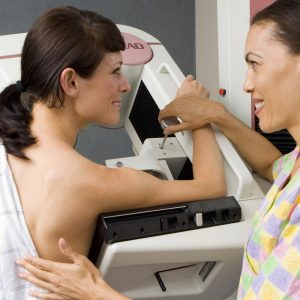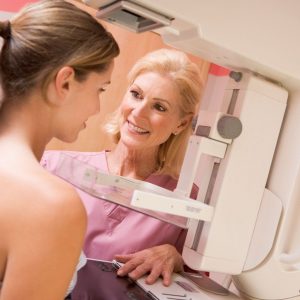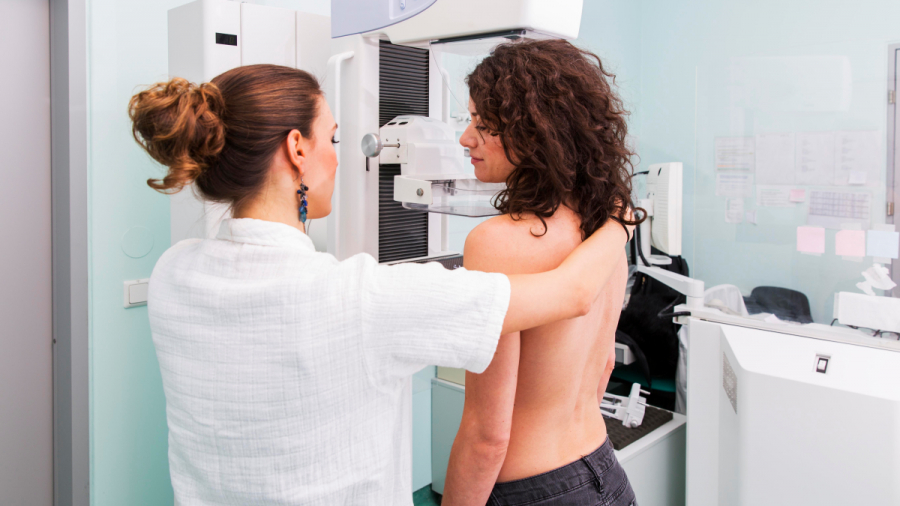Women who are in the group with an average risk of breast cancer are recommended by doctors to undergo a mammogram once every few years, starting at the age of 40.
The American Society of Breast Surgeons has published an updated policy that women at moderate risk should have mammograms annually, with advanced 3D mammography being the preferred option.
During the traditional and most common form of mammography, two x-ray images of the breast are taken. Experts also believe that women are better off doing 3D mammography, which results in many more pictures.

Consultant helping topless woman have mammogram, smiling
“Imagine that the chest is a thick book. Conventional mammography attempts to view all pages at once, squeezing the book as much as possible to make it as thin as possible. And 3D mammography looks at each page individually,” said Deanna J. Attai, MD, assistant professor of surgery at the David Geffen School of Medicine at UCLA.
She explained that the benefit of 3D mammography, also known as tomosynthesis or tomographic reconstruction, has to do with how the images are processed.
“Standard 2D digital mammography allows you to take two images of the breast by squeezing them vertically and horizontally. We then take these two flat images and imagine how they represent the appearance of breasts in 3D space. 3D mammography produces the same two images, but they are processed as thin slices, similar to a CT scan or MRI.
Other than skin cancer, breast cancer is the most common cancer in women in the United States.
The American Cancer Society estimates that more than 268,000 new cases of breast cancer will be diagnosed this year using invasive methods, and more than 40,000 women will die from the disease.
Mammography is currently the most effective and affordable type of breast cancer screening. “Screening mammography has been shown to reduce breast cancer deaths,” said Dr. Onalisa Winblad, a radiologist at the University of Kansas Cancer Center at Kansas City. – Screening mammography has the best chance of detecting breast cancer when it is still at an early stage and is highly treatable. I recommend that women get mammograms every year starting at age 40. This regime will save many more lives.”
Dr. Stamatia Destunis, MD, a radiologist and Fellow of the Radiological Society of North America, believes that women over 40 should switch from traditional to 3D mammography if the facilities they visit have the technology.
Destunis says 3D mammography can more effectively detect malignant tumors in dense breast tissue.
3D mammography results are interpreted on a computer workstation. Although it takes longer to study 3D images, these tests are more accurate.
“Multiple images are taken for each breast, which significantly improves the accuracy of identifying tumors and indurations, and also reduces the likelihood of misdiagnosis or additional examination,” she notes. “About 10 percent of women are scheduled for a follow-up examination because traditional mammography does not always accurately determine the nature of the lump. Three-dimensional mammography helps to reduce the percentage of such “false alarms”.
The mammary gland consists of the mammary ducts and mammary glands (directly glandular tissue), connective (dense) tissue and adipose loose tissue. Some women have more connective tissue than fat. On a standard mammogram, denser connective tissue appears as a solid white shadow, making it difficult to detect tumors.
Experts say that for women with “dense” breasts (that is, with a predominance of connective tissue), 3D mammography is especially effective. “Tight” breasts are more common in younger women and those taking hormonal drugs. “Two-dimensional mammography does not always allow you to see through the dense breast tissue – on it, the tumor also looks like a seal,” notes Attai. “For such cases, it is advisable to use 3D mammography.”
While annual breast screening https://en.wikipedia.org/wiki/Mammography is recommended for women aged 40 and over, some women fear the procedure and avoid it. Diana Miglioretti, PhD, a professor of biostatistics at the University of California, Davis, and a research fellow at California’s Universal Cancer Center, Davis, believes women should be screened regularly and talk about their fears to doctors. “It saves lives,” she says. “The procedure itself is quick and the patient experiences little to no discomfort.”
